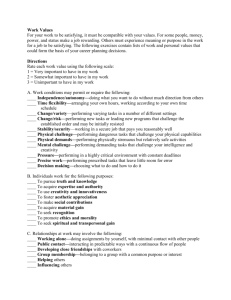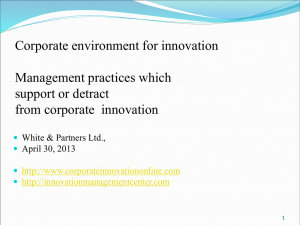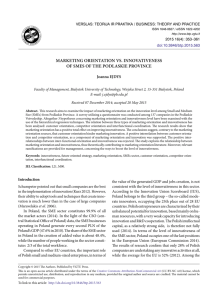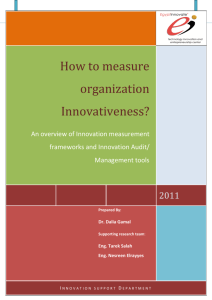INSTRUCTIONS FOR CAMERA
advertisement
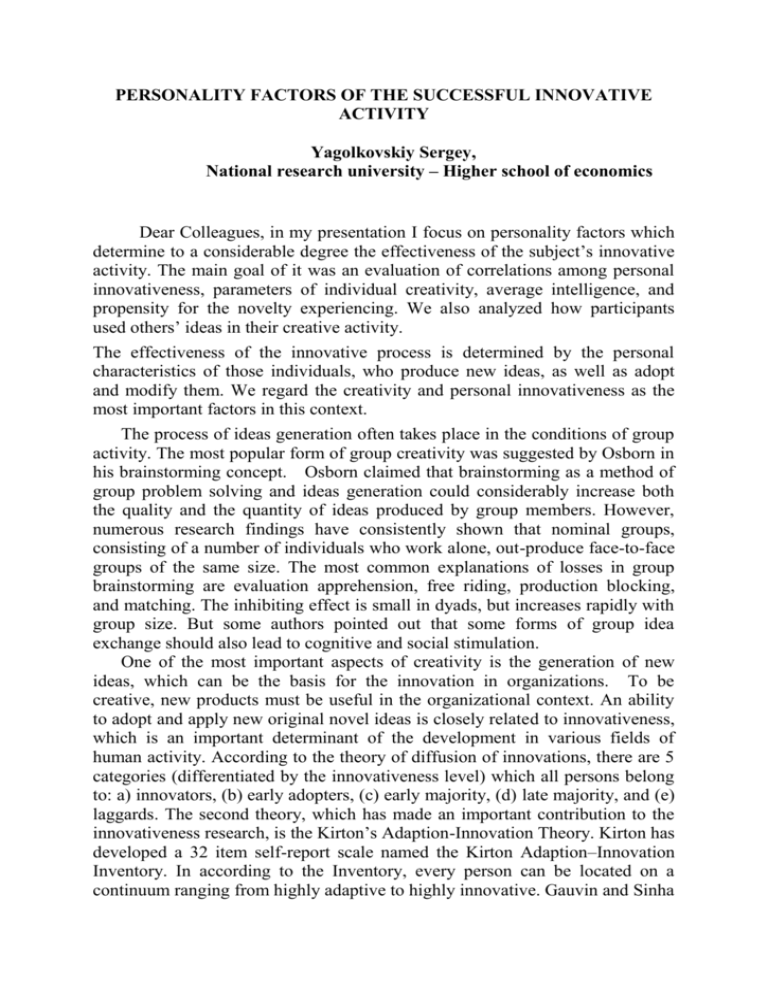
PERSONALITY FACTORS OF THE SUCCESSFUL INNOVATIVE ACTIVITY Yagolkovskiy Sergey, National research university – Higher school of economics Dear Colleagues, in my presentation I focus on personality factors which determine to a considerable degree the effectiveness of the subject’s innovative activity. The main goal of it was an evaluation of correlations among personal innovativeness, parameters of individual creativity, average intelligence, and propensity for the novelty experiencing. We also analyzed how participants used others’ ideas in their creative activity. The effectiveness of the innovative process is determined by the personal characteristics of those individuals, who produce new ideas, as well as adopt and modify them. We regard the creativity and personal innovativeness as the most important factors in this context. The process of ideas generation often takes place in the conditions of group activity. The most popular form of group creativity was suggested by Osborn in his brainstorming concept. Osborn claimed that brainstorming as a method of group problem solving and ideas generation could considerably increase both the quality and the quantity of ideas produced by group members. However, numerous research findings have consistently shown that nominal groups, consisting of a number of individuals who work alone, out-produce face-to-face groups of the same size. The most common explanations of losses in group brainstorming are evaluation apprehension, free riding, production blocking, and matching. The inhibiting effect is small in dyads, but increases rapidly with group size. But some authors pointed out that some forms of group idea exchange should also lead to cognitive and social stimulation. One of the most important aspects of creativity is the generation of new ideas, which can be the basis for the innovation in organizations. To be creative, new products must be useful in the organizational context. An ability to adopt and apply new original novel ideas is closely related to innovativeness, which is an important determinant of the development in various fields of human activity. According to the theory of diffusion of innovations, there are 5 categories (differentiated by the innovativeness level) which all persons belong to: a) innovators, (b) early adopters, (c) early majority, (d) late majority, and (e) laggards. The second theory, which has made an important contribution to the innovativeness research, is the Kirton’s Adaption-Innovation Theory. Kirton has developed a 32 item self-report scale named the Kirton Adaption–Innovation Inventory. In according to the Inventory, every person can be located on a continuum ranging from highly adaptive to highly innovative. Gauvin and Sinha found in the scientific literature three definitions of the personal innovativeness: (1) a characteristic of those who are the first to adopt a new technology; (2) a force that increases the probability of being first to adopt a new technology; (3) a force that enhances adoption of a new technology. One of the most important points in the research on innovativeness is exploration of particular ways of the new ideas adoption and their further implementation. We assume that the propensity for the novelty experiencing is closely related with the personal innovativeness. Innovative activity is a process which is determined by the individual’s desire to find novel ideas, as well as to modify them. In the scientific literature relationship between concepts “creativity” and “innovativeness” is also discussed. Creativity is closely related with production of new, original and potentially useful ideas. But these creative products could be regarded only as the first step in future innovations. Novel ideas and solutions become real innovations only after their adoption and subsequent implementation. Intelligence is also very important determinant of innovation. But we think that the role of intelligence in the innovative performance is quite ambiguous. On the one hand, it helps individual to think in more effective way. On the other hand, intelligence could be regarded often as a barrier for the individual creative activity. The main goal of our study was an evaluation of correlations among main personal factors which determine the effectiveness of the innovation. We also analyzed how participants had used others’ ideas in their own creative activity. The study consisted of two series. Description of the study The 1st series In the 1st series we analyzed relations among parameters of creativity, innovativeness, intelligence, and propensity for the novelty experiencing. The sample consisted of 145 students (92 males and 53 females). Parameters of creativity were assessed in psychometric paradigm. We used as a measuring tool J.Guilford’s verbal test of creative thinking “unusual use” in I.S. Averina and E.I.Shcheblanova’s russian adaptation. This test is represented in the kind of two parallel and interchangeable forms. It requires participants to generate ideas concerning unusual applications of the ordinary objects (in the first parallel form it was a newspaper, in the second – a wooden rule respectively). This test is the most popular and often used one. Its advantages are: easiness in implementing and quickness of testing, which lowers a level of weariness factor’s manifestation among subjects. In the subjects’ creativity diagnostics, we analyzed the following parameters: productivity (a total number of ideas proposed by a subject); flexibility (a number of semantic categories subjects’ proposed ideas relates to); originality (singularity and statistical rarity of subjects’ proposed ideas, estimated by five-point scale - from 1 to 5 points). For the assessment of participants’ innovativeness we used the Kirton Adaption – Innovation Inventory (KAI). The average intelligence was assessed by the Free Wonderlic Test. We measured the need for the novelty experiencing by using the Zuckerman Sensation Seeking Scale. In the 1st series participants were given one form of the J.Guilford’s verbal test of creative thinking “unusual use” only. They should think up during assigned 6 minutes a maximum number of all possible applications of standard newspaper. Afterwards, they answered questions of the KAI and the Zuckerman Sensation Seeking Scale. Finally, they performed the Free Wonderlic Test. Results of the 1st series of our study showed that there is no significant correlation between the most important personality factors of innovation: innovativeness and creativity. We did not find significant relations between innovativeness and average intelligence, too. On the contrary, correlation between personal innovativeness and propensity for the novelty experiencing was significantly positive (rs =.4, p<0.05). We also revealed that productivity of participants’ creative performance has positive significant relations with their intelligence (rs =.35, p<0.05) and flexibility (rs=.7, p<0.01). The 2nd series In the 2nd experimental series we analyzed correlations among creativity, innovativeness, and quantity of others’ ideas use. The sample consisted of 464 students: 157 males and 307 females. All participants had not been informed of the purpose of the study. For the assessment of individual creativity we used two parallel and interchangeable forms of the mentioned J.Guilford’s verbal test of creative thinking “unusual use” in I.S. Averina and E.I.Shcheblanova’s adaptation. Objects were as follows: wooden rule and newspaper. Participants’ innovativeness was assessed by the Kirton Adaption – Innovation Inventory (KAI). Diagnostics of the individual creativity and innovativeness was done in the same way like in the 1st series. We also assessed how participants utilized others’ ideas in the context of their own creative activity. It was done in the context of the idea exposure paradigm. First, each participant generated ideas concerning unusual applications of newspaper (stage 1). Before accomplishing the second part of diagnostics procedure, respondents had been given stimulus material - typewritten list of 11 ideas regarding uncommon application of wooden ruler. Afterwards, they were reading them out for one minute. Finally, participants got instruction to think up, on one’s own, a maximum number of wooden rule’s applications (stage 2). Each subject could see the list with stimulus ideas till the end of the experiment. Moreover, participants could use (and it was mentioned in the instruction) information, obtained from the text with stimulus material, to their own discretion. We counted the number of ideas produced by each participant, which belonged to the following two categories: identical to stimulus ideas under the formulation (participants transferred stimuli without any changes in their own “creative” products); identical to stimuli on sense (they re-formulated stimulus ideas or modified them extracting main principles of unusual use of the given object). Duration of the ideas generation process concerning unusual uses of each object was 6 min. Correlation analyses were performed to determine the relationships among the creativity parameters, quantity of others’ ideas use (by two different ways separately), and personal innovativeness. The results showed that quantity of others’ ideas modifications and participants’ innovativeness scores showed a positive relationship (rs =.27, p<0.05). We also found positive correlation approximately the same size between different types of others’ ideas use (rs =.28, p<0.05). But we could not find any significant correlation between innovativeness and the quantity of stimulus ideas, which individuals included in the list with their own creative products without any changes. Experimental data also showed that there are no significant relationships between particular creativity parameters and both innovativeness and frequency of others’ ideas use. Discussion The main objective of our study was assessment of relations among different personal characteristics of individuals in the context of their innovative activity. As it was mentioned above, we had not found significant correlations between the most important determinants of innovations: creativity and innovativeness. This fact contradicts the notion that creativity and personal innovativeness closely related to each other. But it looks as a partial support for the statement that creativity could be the first step in future innovations. It was expected that creativity would have negative correlation with quantity of others’ ideas use. We assumed that creative people tend to produce their own novel ideas only refusing to use others’ creative products. But significant correlation between the mentioned personal characteristics could not be found. We explain these results by the following statement: individuals use various strategies when they are processing the novel and creative content. Some of them work with their own creative ideas only, refusing to take into consideration others’ creative products. Other individuals tend to be attentive to others’ ideas and intensively use them in their own creative activity. This statement was partially supported by our next finding: obtained data revealed significant correlation between different types of others’ ideas use. It can be explained by the hidden propensity of some participants to apply stimuli to their own creative process in various ways. But this result can be also regarded as a basis for the differentiating between motivational and cognitive-behavioural determination of the innovativeness. Motivational determinants of personal innovativeness are activated when subject is acquiring new ideas and adopting them. Cognitive factors determine mostly a process of making decisions about particular ways of others’ ideas implementation and modification. We did not find significant correlation between participants’ innovativeness and the quantity of stimulus ideas, which they had included in the list with their own creative products without any changes. So, results of the correlation analysis did not support our prediction that participants’ personal innovativeness correlates negatively with this type of others’ ideas use. We did not find significant correlation between innovativeness and average intelligence. This result looks as an argument which does not support the idea about existence of the concept of “cognitive innovativeness”. On the contrary, correlation between personal innovativeness and propensity for the novelty experiencing was significantly positive (p<0.05). This finding confirms our prediction that sensational sphere and motivation to experience new emotions are closely related to the personal innovativeness. Results of the presented study can be applied to enhancing the individual creativity and innovativeness, as well as to various procedures and stages of the innovation management.
